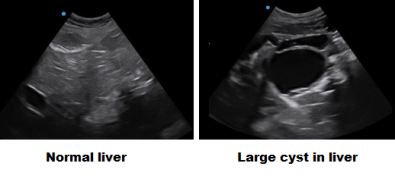Ultrasound
When a pet is sick and you need more information to get a diagnosis, ultrasound is wonderful. It’s a state-of-the-art diagnostic tool that looks inside the body. Ultrasound gives a different picture than x-rays do and provides additional information. It gives us more detail of the internal organs and lets us know if there is fluid in the abdomen. High-frequency sound waves are used to produce images of the structures within the body. Since no radiation is used, it is safer than x-rays. However, the real benefit is that we can diagnose some conditions with ultrasound that x-rays miss.
For example, a cat came in because she wasn’t feeling well and her belly was swollen. Blood tests indicated something was wrong with the liver so we initially took an x-ray. The x-ray showed that the liver was large but not why. Ultrasound quickly gave us the diagnosis. The cat had fluid-filled cysts throughout her liver and kidneys. It was a congenital problem that she was born with that her body could no longer cope with. Without ultrasound, we would have never known what caused the liver to enlarge.
We also use ultrasound to obtain urine samples from pets. The ultrasound shows us exactly where the bladder is and how full it is. We can use a needle and syringe to draw a sample of urine directly from the bladder. This is the preferred method to obtain urine for a culture to avoid contamination. Sometimes it’s the only way to get urine from a cat.







